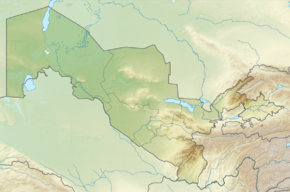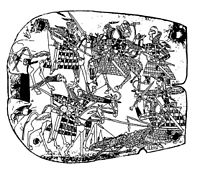Orlat plaques
| Orlat plaques | |
|---|---|
 Orlat plaques | |
| Material | Bone |
| Size | 11 cm × 13.5 cm (4.3 in × 5.3 in) |
| Created | 1st–4th century CE |
| Place | Nomadic tomb, Orlat cemetery, Kurgan |
| Present location | Institute of Art Studies, Academy of Sciences of the Republic of Uzbekistan |
| Culture | Saka |
TheOrlat plaquesare a series of bone plaques that were discovered in the mid-1980s inUzbekistan.They were found during excavations led byGalina Pugachenkovaat the cemetery ofOrlat,by the bank of theSaganak River(a tributary of theZeravshan), immediately north ofSamarkand.[1][2]Pugachenkova published her finds in 1989. The left half is decorated with an elaborated battle scene, while on the other side is depicted a hunting scene.
The plaques[edit]
The plaques are thought to have been decorative beltbuckles.They are decorated with battle scenes between soldiers armed ascataphracts,and one hunting scene. There are three other plaques, smaller in size, on which are depicted a vulture, fighting Bactrian camels, and warriors.[1][3]The date and attribution of the plaques are disputed, although the consensus tends to suggest a 1st-century CE date.
The plaque with the battle scene depicts a clash with armored warriors. There are soldiers battling on foot, and before them there is a horseman brandishing a sword clashing with another horseman relying on his lance. A warrior has been deprived of his horse down to the right. His lance is broken and he prepares, with his sword, to fight his opponent, a horseman lunging on him with a lance.[3][1][4]According to Markus Mode, the composition was originally larger, and it was copied from another source.[1]
One hypothesis is that the plaque depicts a battle between the sedentary Sogdians and the nomadic invaders. In it, the Sogdian hero, leader of his group, repels the attacks of the groups of nomads. For the Sogdians the nomadic incursions were a real threat. According to Mode there is more to it than the record of a battle. The plaque is "a very early manifestation of the narrative imagery that characterizes Sogdian art—one that finds its supreme expression in the painted cycles of 7th- and early 8th-centuryPanjikent."[1]Thus, the purpose ofSogdian artwas to transmit narrative. In their paintings and carvings, "Sogdian artists would include only the essentials. Lines, blocks of color, and a few landscape elements to set the scene create an easy-to-read two-dimensionality that helps advance the progress of the depicted tale." As noted by Mode, this style's origin may be seen in two Orlat plaques.[3][1]
Yury Khudyakovfound numerous similarities between the plaques and otherXiongnu-Sarmatianfinds fromMongoliaandAltay,particularly a group of plaques retrieved from Tepsei Mount near theYenisey River,usually attributed toTashtyk culture.[1]
Pugachenkova believes the plaques were made by the inhabitants ofKangju,thought to have been closely related to theKushansandTocharians.The Kangjus were probably Scythians, opposed to the Kushans, as seen inKhalchayan.[5]Overall, the soldiers would be eitherSogdiansorSakas,[6]much less probablyYuezhisorParthians.
-
Full drawing of one of the Orlat plaques.
-
Orlat plaque horserider.
-
Orlat archer (detail of the plaque).
-
Orlat axeman (detail of the plaque).
-
Orlat plaque encounter.
-
Orlat plaque encounter.
-
Orlat plaque hunter.
Parallels[edit]
The equipment of the warriors in the Orlat plaques is comparable to the equipement of theIndo-Scythiansas seen in coins of theIndo-ScythiankingAzes II.[9]The figures of the hunters on the reverse are also comparable to the depictions of hunters on an ivory plaque fromTakht-i Sangin.[10]These designs are broadly consistent in identifying theSakaor the Saka-Kangjutribes of Central Asia, which were regularly in conflict with theYuezhis.[10]
-
Orlat warrior and warrior on a coin ofAzes I.
-
Hunters in an ivory plaque fromTakht-i Sangin,with design comparable to the hunting scenes of the Orlat plaques.[12]
-
Model of a Sakacataphractarmour with neck-guard, fromKhalchayan.1st century BCE.Museum of Arts of Uzbekistan,nb 40.[13]
References[edit]
- ^abcdefLerner, Judith A."Orlat Plaques".Freer, Sackler - Smithsonian.Archived fromthe originalon 11 September 2021.Retrieved11 September2021.
- ^Thomas A. Green; Joseph R. Svinth (2010). Joseph R. Svinth, Thomas A. Green (ed.).Martial Arts of the World An Encyclopedia of History and Innovation · Volume 2.ABC-CLIO.p. 59.ISBN978-1-78671-699-6.
- ^abcBellemare, Julie; Lerner, Judith A."The Sogdians at Home - Art and Material Culture".Freer, Sackler - Smithsonian.Archived fromthe originalon 11 September 2021.Retrieved11 September2021.
- ^Baumer, Christoph (2018).History of Central Asia, The: 4-volume Set.Bloomsbury Publishing.p. 96.ISBN978-1-83860-868-2.
- ^Cribb, Joe; Herrmann, Georgina; Academy, British (26 July 2007).After Alexander: Central Asia Before Islam.OUP/British Academy. pp. 62–63.ISBN978-0-19-726384-6.
"The engraved bone plaques found at Orlat in the region of Koktepe and dated by Jangar Ilyasov (2003) to the first-second centuries AD present the portraits of Kangju warriors and hunters", the Kangjus were the "western 'Scythian' neighbours" of the Yuezhi/ Kushans.
- ^Betts, Alison; Vicziany, Marika; Jia, Peter Weiming; Castro, Angelo Andrea Di (19 December 2019).The Cultures of Ancient Xin gian g, Western China: Crossroads of the Silk Roads.Archaeopress Publishing Ltd. p. 104.ISBN978-1-78969-407-9.
- ^"Orlat Plaques The Sogdians".sogdians.si.edu.
- ^Grenet, Frantz (2012)."« The nomadic element in the Kushan empire (1st - 3rd century AD)".Journal of Central Eurasian Studies.3:14.
- ^Betts, Alison; Vicziany, Marika; Jia, Peter Weiming; Castro, Angelo Andrea Di (19 December 2019).The Cultures of Ancient Xin gian g, Western China: Crossroads of the Silk Roads.Archaeopress Publishing Ltd. p. 104.ISBN978-1-78969-407-9.
- ^abBetts, Alison; Vicziany, Marika; Jia, Peter Weiming; Castro, Angelo Andrea Di (19 December 2019).The Cultures of Ancient Xin gian g, Western China: Crossroads of the Silk Roads.Archaeopress Publishing Ltd. p. 105.ISBN978-1-78969-407-9.
- ^Betts, Alison; Vicziany, Marika; Jia, Peter Weiming; Castro, Angelo Andrea Di (19 December 2019).The Cultures of Ancient Xin gian g, Western China: Crossroads of the Silk Roads.Archaeopress Publishing Ltd. p. 104.ISBN978-1-78969-407-9.
- ^Betts, Alison; Vicziany, Marika; Jia, Peter Weiming; Castro, Angelo Andrea Di (19 December 2019).The Cultures of Ancient Xin gian g, Western China: Crossroads of the Silk Roads.Archaeopress Publishing Ltd. p. 105.ISBN978-1-78969-407-9.
- ^Frantz, Grenet (2022).Splendeurs des oasis d'Ouzbékistan.Paris: Louvre Editions. p. 56.ISBN978-84-125278-5-8.
Sources[edit]
- Les Saces,Iaroslav Lebedynsky, Paris: Errance, c2006.ISBN2-87772-337-2
- Худяков Ю.С. Образ воина в таштыкском изобразительном искусстве // Семантика древних образов. Novosibirsk, 1990. Page 112.
- (in Russian)Detailed description of Orlat finds
- The Orlat Battle Plaque and the Roots of Sogdian Art,Markus Mode, in M. Compareti, P. Raffetta, and G. Scarcia (eds.) Ērān ud Anērān: Studies Presented to Boris Il'ič Maršak on the Occasion of his 70th Birthday, Venice: Libreria editrice Cafoscarina
External links[edit]
- The Orlat battle plaques
- "Orlat Plaques The Sogdians".sogdians.si.edu.





![Detail of one of the Orlat plaques.[7] A severed head is probably hanging in front of the horse.[8]](https://upload.wikimedia.org/wikipedia/commons/thumb/a/a8/Orlat_plaque_%28horserider%29.jpg/188px-Orlat_plaque_%28horserider%29.jpg)





![A coin of the Indo-Scythian king Azes II with equipment similar to that of the Orlat plaque.[11]](https://upload.wikimedia.org/wikipedia/commons/thumb/0/07/AzesIIFineCoin.jpg/200px-AzesIIFineCoin.jpg)

![Hunters in an ivory plaque from Takht-i Sangin, with design comparable to the hunting scenes of the Orlat plaques.[12]](https://upload.wikimedia.org/wikipedia/commons/thumb/0/0b/Right_hunter_detail%2C_Takht-i_Sangin%2C_Temple_of_the_Oxus%2C_1st_century_BCE-_1st_century_CE.jpg/200px-Right_hunter_detail%2C_Takht-i_Sangin%2C_Temple_of_the_Oxus%2C_1st_century_BCE-_1st_century_CE.jpg)
![Model of a Saka cataphract armour with neck-guard, from Khalchayan. 1st century BCE. Museum of Arts of Uzbekistan, nb 40.[13]](https://upload.wikimedia.org/wikipedia/commons/thumb/6/64/Kalchayan_Prince_%28armour%29.jpg/141px-Kalchayan_Prince_%28armour%29.jpg)